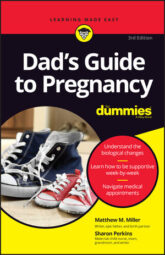Although the majority of pregnancies really do go like clockwork, things can and do go wrong, which is a fear for new Dads. In early pregnancy, the biggest threat is miscarriage. One in four women has a miscarriage at some point in her reproductive life. Another, less common threat is an ectopic pregnancy.
Miscarriage is more common as women age, and though you may not consider your partner "old" if she's older than 40, Mother Nature does, at least for childbearing purposes. In fact, doctors used to refer to pregnant women older than 35 as "elderly."
The reason that miscarriage increases with age is that her eggs, which have been hanging around since before she was born, have aged, and you can't put face cream on eggs and have them look younger. The good eggs get used up first, so the ones left are more likely to be chromosomally abnormal. Miscarriage rates by age break down like this:
Under age 35: 15 percent
36 to 40: 17 percent
41 to 45: 34 percent
Older than 45: 53 percent
Keep in mind that these miscarriage rates are averages and that a woman's actual risk depends on many other health factors. These numbers describe the potential risk after a pregnancy is diagnosed. Before the first missed period, many pregnancies are lost when they start to implant but then stop growing, usually because they're chromosomally abnormal.
The symptoms of miscarriage are bleeding that becomes heavier over time, passing clots, and abdominal cramping. If your partner is newly pregnant, she may just have what seems like an unusually heavy period around the time of her period or shortly afterward. Pregnancies that end this early are often called chemical pregnancies.
Some women have spotty bleeding that isn't continuous, sometimes called a threatened abortion. (Abortion is the medical term for a miscarriage.) Some medical personnel still prescribe bed rest for women with spotting, although studies show it really doesn't change the risk of miscarriage.
Chromosomally abnormal embryos cause an overwhelming number of miscarriages. You and your partner didn't cause the miscarriage, and neither of you could have prevented it. But although miscarriage is a natural event, it's still an emotional loss (to varying degrees for different people), and talking about how you feel is an important part of coping.
Allow yourself and your partner to mourn the loss of the baby, no matter how early in the pregnancy it occurs.
Having one or two miscarriages doesn't increase the risk of it happening again, but women with three or more miscarriages should see a fertility specialist to determine the cause, if possible. Following are some of the possible causes of recurrent miscarriage (defined as three or more losses):
Chromosomal abnormalities: You or your partner may carry genes that are causing recurrent miscarriage. Genetic testing can help determine the cause.
Immune system problems: Women who have autoimmune disease can have recurrent miscarriages. Treatment with medication may reduce pregnancy loss.
Incompetent cervix: An incompetent cervix dilates prematurely because it's been weakened by trauma, congenital deformities, or a previous surgical procedure. Women whose moms took DES to help prevent miscarriage may have incompetent cervixes. Miscarriage usually occurs after 12 weeks. Incompetent cervixes cause around 5 percent of recurrent miscarriages and can be treated by placing a stitch in the cervix to hold it closed.
Low progesterone levels: Sometimes progesterone levels are too low to sustain a pregnancy. In these cases, supplementation helps.
Uterine abnormalities: Fibroids, polyps, scar tissue, or congenital uterine malformations can prevent the pregnancy from implanting properly in 15 to 20 percent of recurrent miscarriage cases. Surgical correction of the abnormality may help.
After a miscarriage, many women pass all the tissue and need no further medical care. Others need tissue surgically removed so it doesn't cause infection or continued bleeding. This procedure, called a dilatation and curettage, or D&C for short, is done as an outpatient procedure.
If your partner passes tissue, be sure to save it and take it to your medical practitioner so she can see that everything's been passed and possibly test to figure out what happened. When cramping intensifies, keep a clean container with a lid in the bathroom so you can collect any tissue as it passes.
Take the tissue to your practitioner's office as soon as possible; keep the container in the refrigerator or follow your practitioner's instructions on where to take it if a miscarriage occurs during the weekend.
The miscarriage may be diagnosed afterward as a blighted ovum, a pregnancy where the embryo stops developing and only the placenta grows. Blighted ovum is the most common type of chromosomally abnormal pregnancy. It can't be predicted or prevented; a certain percentage of embryos are chromosomally abnormal, and one blighted ovum doesn't mean the problem will recur in the next pregnancy.

